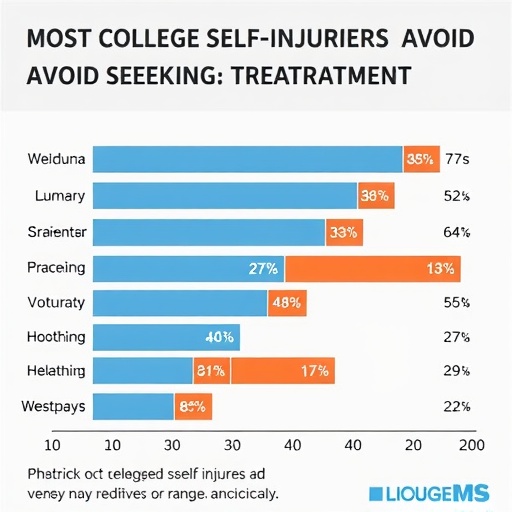A ground-breaking international study has revealed a startling statistic that illuminates the mental health challenges faced by college students worldwide: 70% of those who engage in non-suicidal self-injury (NSSI) do not seek professional treatment. Published in the International Journal of Mental Health and Addiction, this study embarks on an in-depth exploration into the patterns, prevalence, and psychological ramifications of NSSI across diverse cultures and educational systems. The researchers’ findings are poised to redefine how mental health interventions are designed and implemented for young adults, particularly within academic environments.
Non-suicidal self-injury encompasses a range of deliberate, self-inflicted physical harm behaviors without suicidal intent, often used as a maladaptive coping mechanism to manage overwhelming emotional distress. Despite the severity and visibility of such actions, there remains a significant gap between those affected and those pursuing professional help, dubbed by some in the field as the “treatment gap.” This study is the first to provide comprehensive, cross-national statistics highlighting the pervasive nature of this phenomenon and its global implications.
The research harnessed data collected from thousands of college students across multiple countries, integrating both quantitative surveys and qualitative interviews to deliver a robust, multidimensional view of NSSI behaviors. Importantly, the study examined not only the raw prevalence rates but also contextual factors influencing treatment-seeking behaviors, ranging from stigma and cultural perceptions of mental health to accessibility and awareness of mental health services. Such a holistic approach enables a nuanced understanding of why students refrain from seeking help.
One of the study’s pivotal insights points to the role of perceived stigma surrounding mental health and self-injury within academic communities. Many students harbor fears of judgment or discrimination, which significantly discourage them from disclosing their behaviors or accessing care. This social invisibility compounds the emotional isolation often experienced by individuals engaging in NSSI, perpetuating a vicious cycle of silence and untreated distress.
Additionally, the study reveals disparities in mental health literacy among college populations globally. In some regions, a lack of information about NSSI and available treatment options correlates strongly with lower rates of help-seeking. This suggests that educational initiatives targeting both students and faculty could be instrumental in bridging the treatment gap by normalizing conversations around mental health and providing clear, accessible pathways to support.
Technological factors also surfaced as influential determinants. The ease of access to online communities – both supportive and harmful – affects how students manage their self-injury. While some find solace and anonymity in digital spaces, these platforms can sometimes enable behaviors or discourage professional treatment, particularly when misinformation circulates unchecked. This highlights the importance of integrating digital literacy and therapeutic support within mental health strategies.
Methodologically, the study employed rigorous statistical analyses, including logistic regression models, to pinpoint the predictors of treatment avoidance among self-injuring students. These predictive models accounted for variables such as gender, socioeconomic status, geographic location, and severity of injury. The sophisticated data treatment lends credibility and generalizability to the findings, making them valuable for policymakers and health practitioners alike.
Moreover, the international scope of the study underscores the universality of NSSI as a public health concern. While prevalence rates varied between countries, the consistent pattern of low treatment engagement suggests systemic barriers that transcend cultural boundaries. These insights challenge mental health organizations to adopt global, culturally sensitive approaches rather than isolated, nation-specific solutions.
An unexpected revelation from the data showed gender differences in self-injury and help-seeking behaviors. Female students displayed higher rates of NSSI but also slightly higher rates of treatment engagement compared to males. This discrepancy calls for gender-responsive interventions that address unique psychological and sociocultural barriers to care for different student groups.
From a clinical standpoint, the study advocates for embedding mental health services within the campus infrastructures and promoting early identification programs. Peer-led initiatives, accessible counseling, and training for academic staff can create supportive environments that encourage affected students to seek help before issues escalate. Such institutional changes could dramatically reduce the prevalence and severity of untreated self-injury.
It is noteworthy that the study also discussed the implications of untreated NSSI on long-term mental health outcomes. Non-suicidal self-injury is a recognized risk factor for subsequent suicidal behaviors, depression, and anxiety disorders. Therefore, the treatment gap identified not only affects immediate well-being but also potentially escalates the risk trajectory for vulnerable populations, signaling an urgent call for targeted intervention strategies.
The authors propose integrating preventative education within broader mental health promotion frameworks on campuses. Emphasizing emotional regulation, resilience-building, and destigmatization campaigns can empower students to manage psychological challenges constructively. Moreover, leveraging technology to deliver confidential, scalable mental health resources could mitigate many access barriers identified.
In summation, this robust international investigation into non-suicidal self-injury among college students spotlights a critical and under-addressed aspect of young adult mental health. With 70% of those affected foregoing professional treatment, the study’s findings stress the need for systemic changes that reduce stigma, increase awareness, and improve service accessibility. As educational institutions grapple with growing mental health demands, the insights presented pave the way for innovative, inclusive strategies designed to reach the silent majority in distress.
Looking forward, the researchers emphasize the necessity for longitudinal studies to monitor evolving trends in NSSI and help-seeking behaviors over time and to evaluate the impact of implemented interventions. Expanding research to include non-college populations may also offer a fuller understanding of the broader social dynamics influencing self-injury. Ultimately, this foundational work provides a critical evidence base for future mental health policy and practice aiming to rescue students entangled in cycles of self-harm and silence.
Subject of Research:
Non-suicidal self-injury (NSSI) and treatment-seeking behaviors among college students across multiple countries.
Article Title:
70% of College Students Who Engage in Non-Suicidal Self-injury Do Not Seek Treatment: An International Study.
Article References:
Lindquist, E.G., Aviv, E.C., Magner-Parsons, B. et al. 70% of College Students Who Engage in Non-Suicidal Self-injury Do Not Seek Treatment: An International Study. Int J Ment Health Addiction (2025). https://doi.org/10.1007/s11469-025-01589-w
Image Credits:
AI Generated
DOI:
https://doi.org/10.1007/s11469-025-01589-w
Tags: academic environments and mental healthbarriers to seeking mental health treatmentcollege mental health challengescollege students and self-harmcoping mechanisms for emotional distresscross-national statistics on NSSIinternational study on NSSImental health interventions for young adultsnon-suicidal self-injury prevalencepsychological ramifications of self-injuryqualitative research in psychologytreatment gap in self-injury





